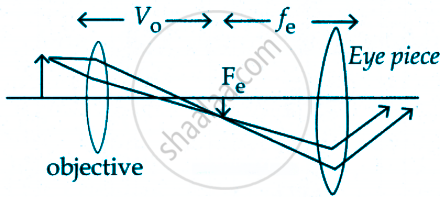Advertisements
Advertisements
प्रश्न
A compound microscope has a magnifying power of 100 when the image is formed at infinity. The objective has a focal length of 0.5 cm and the tube length is 6.5 cm. What is the focal length of the eyepiece.
उत्तर
`"v"_circ + "f"_"e"` = 6.5 cm ....(1)
m = `"v"_circ/"u"_circ xx "D"/"f"_"e"` [taking D = 25 cm]
`=> "m" = - [1 - "v"_circ/"f"_circ] "D"/"f"_"e"`
`100 = - [1 - "v"_circ/0.5] 25/"f"_"e"`
`100 "f"_"e" = - (1 - 2"v"_circ) xx 25`
`2"v"_circ - 4 "f"_"e" = 1` .....(2)
Solving equation (1) and (2) we can get,
v0 = 4.5 cm and fe = 2 cm

APPEARS IN
संबंधित प्रश्न
Answer the following question in detail.
How does magnifying power differ from linear or lateral magnification?
Answer the following question in detail.
What is a terrestrial telescope and an astronomical telescope?
Discuss about simple microscope and obtain the equations for magnification for near point focusing and normal focusing.
Why is oil-immersed objective preferred in a microscope?
What are the advantages and disadvantages of using a reflecting telescope?
What is the remedy of myopia?
What is the remedy of hypermetropia?
Obtain the equation for resolving the power of the microscope.
Discuss about astronomical telescope.
A compound microscope has a magnification of 30. The focal length of eye piece is 5 cm. Assuming the final image to be at least distance of distinct vision, find the magnification produced by the objective.
When a convex lens of 12.5 cm focal length is used as a magnifying glass, normal eye can see an object clearly at a distance of 25 cm. The magnifying power of the instrument is ____________.
If astronomical telescope of length 1.53 m has magnifying power of magnitude 50, the values of fo and fe are ____________.
The speed of light in media 'A' and 'B' are 2.0 × 1010 cm/s and 1.5 × 1010 cm/s respectively. A ray of light enters from medium B to A at an incident angle 'θ'. If the ray suffers total internal reflection, then ______.
An object viewed from a near point distance of 25 cm, using a microscopic lens with magnification '6', gives an unresolved image. A resolved image is observed at infinite distance with a total magnification double the earlier using an eyepiece along with the given lens and a tube of length 0.6 m, if the focal length of the eyepiece is equal to ______ cm.
An observer looks at a distant tree of height 10 m with a telescope of magnifying power of 20. To the observer the tree appears:
The image formed by an objective of a compound microscope is ______.
